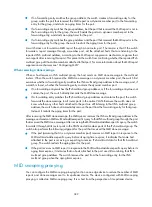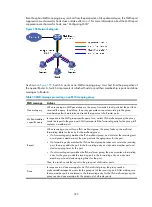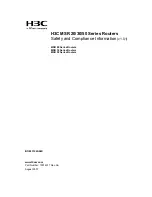
376
Figure 100
RPF check process
When POS 5/1 of Router C receives an IPv6 multicast packet, because the interface is the incoming
interface of the (S, G) entry, the router forwards the packet to all outgoing interfaces.
When POS 5/0 of Router C receives an IPv6 multicast packet, because the interface is not the incoming
interface of the (S, G) entry, the router performs an RPF check on the packet. The router searches its IPv6
unicast routing table and finds that the outgoing interface to Source (the RPF interface) is POS 5/1. This
means that the (S, G) entry is correct but the packet traveled along a wrong path. The RPF check fails and
the router discards the packet.
IPv6 multicast forwarding across IPv6 unicast subnets
Routers forward the IPv6 multicast data from an IPv6 multicast source hop by hop along the forwarding
tree, but some routers might not support IPv6 multicast protocols in a network. When the IPv6 multicast
data is forwarded to a router that does not support IPv6 multicast, the forwarding path is blocked. In this
case, you can enable IPv6 multicast data forwarding across the IPv6 unicast subnets by establishing a
generic routing encapsulation (GRE) tunnel between the routers at both ends of the IPv6 unicast subnets.
For more information about GRE tunneling, see
Layer 3—IP Routing Configuration Guide
.
Figure 101
IPv6 multicast data transmission through a tunnel
As shown in
, with a GRE tunnel established between the multicast routers Router A and Router
B, Router A encapsulates the IPv6 multicast data in unicast IPv6 packets, and forwards them to Router B
Receiver
Receiver
Source
2000::101/16
Router A
Router B
Router C
POS5/1
POS5/0
POS5/0
IPv6 Multicast packets
Destination/Prefix
IPv6 Routing Table on Router C
2000::/16
Interface
POS5/1
















































